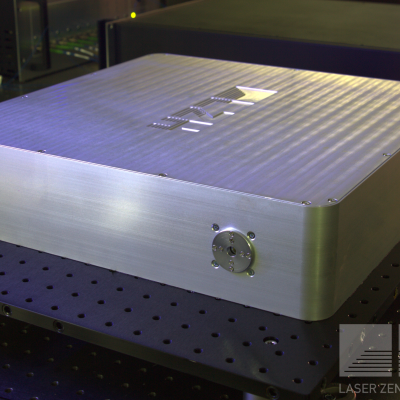LZH builds laser amplifier for space-based optical communication network
The European Space Agency (ESA) is developing a purely optical satellite system designed to reduce the load on terrestrial fiber optic networks in transmitting data streams. LZH researchers have created a prototype fiber-based laser amplifier for such a satellite system, operating in the 1 μm wavelength range, showcasing the fundamental feasibility of this technology.
Fiber amplifier with high transmission rate and efficiency
The highly efficient fiber amplifier (High Efficiency Laser Amplifier - HELA) with a total optical output power of 100 watts enables communication using Wavelength Division Multiplexing (WDM). It amplifies ten closely spaced wavelengths simultaneously in a single fiber, thereby supporting ten separate data channels and increasing the transmission rate of the system. The individual fiber components, including the pump light coupler, cladding mode stripper, and end cap, were also developed and manufactured at the LZH.
The researchers achieved an overall wall-plug efficiency of around 30 percent for the amplifier system using the fiber technology, marking a significant improvement compared to traditional amplifier systems operating in the classic telecom wavelength range of 1.5 µm. By specially adapting the amplifier configuration, the scientists ensured nearly identical amplification for all ten wavelengths.
Goal: Greater independence from terrestrial infrastructure
Through the HydRON project (High-throughput Optical Network), ESA aims to create an optical satellite network seamlessly integrated with terrestrial fiber networks, providing data transmission rates of up to one terabit per second. This satellite system seeks to enhance independence from terrestrial infrastructure, enabling optical ground stations to facilitate communication in remote areas where fiber networks are not feasible. Additionally, an optical space network could take over data communication responsibilities if terrestrial infrastructures, such as submarine cables, are damaged or fail.
The "Optical Amplifier with Enhanced Wall-plug Efficiency" project was funded by ESA under grant number 4000132172/20/NL/AR.
Laser Zentrum Hannover e.V. (LZH)
As an independent, non-profit research institute, the Laser Zentrum Hannover e.V. (LZH) stands for innovative research, development, and consulting. Supported by the Lower Saxony Ministry of Economics, Transport, Building and Digitalization, the LZH is dedicated to selflessly promoting applied research in the field of photonics and laser technology. Founded in 1986, almost 200 employees are now working at the LZH.
The LZH offers solutions to current and future challenges with its smart photonics. Along the process chain, natural scientists and engineers work interdisciplinary together: from component development for specific laser systems or for quantum technologies to process developments for a wide variety of laser applications, for example for medical and agricultural technology or lightweight construction in the automotive sector. 18 successful spin-offs have emerged from the LZH to date. Thus, the LZH creates a strong transfer between fundamental science, application-oriented research, and industry - and uses light for innovation.


